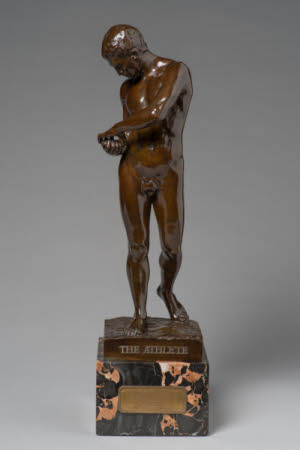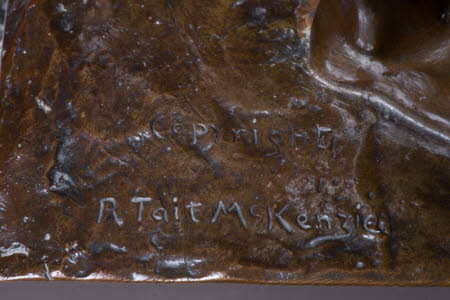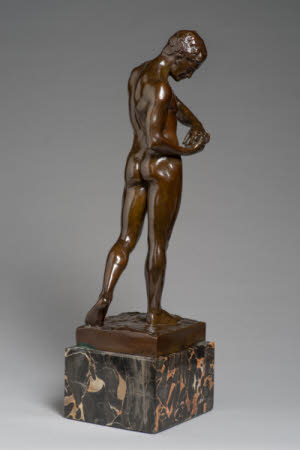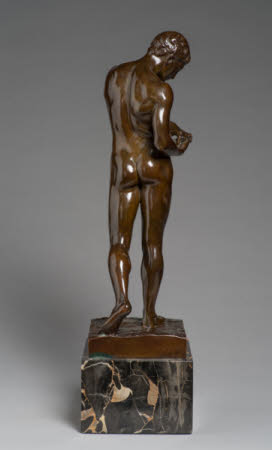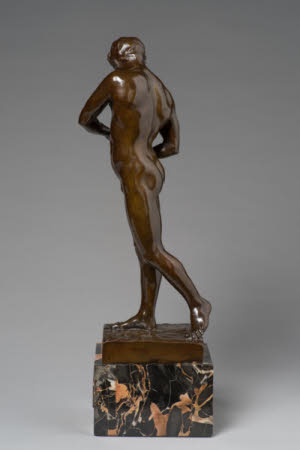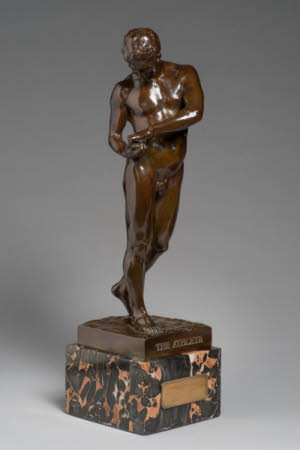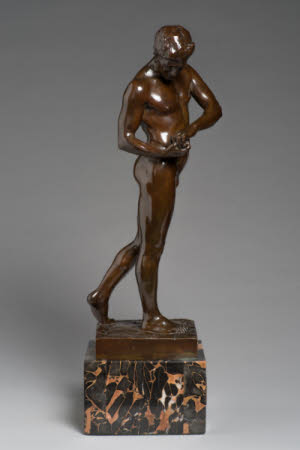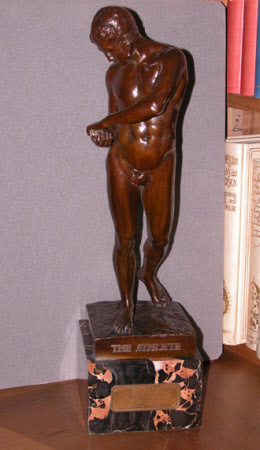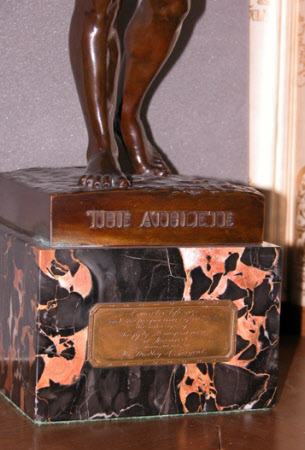The Athlete
Robert Tait McKenzie (Almonte, Ontario 1867 - Philadelphia 1938)
Category
Art / Sculpture
Date
1903
Materials
Bronze and marble
Measurements
542 mm (Height)
Place of origin
New York City
Order this imageCollection
Anglesey Abbey, Cambridgeshire
NT 515046
Summary
Bronze, The Athlete, Robert Tait McKenzie (1867-1938), cast Roman Bronze Works, New York City, designed in 1903, signed on base ‘R. Tait McKenzie’. A bronze figure of a naked man, entitled ‘The Athlete’, by Robert Tait McKenzie (1867-1938), designed in 1903. The young man is shown moving forward, with weight on right foot, turned to his right and using both hands to take the grip-strength test. On integral bronze base, mounted on variegated marble base. Cast by the Roman Bronze Works, New York City. Signed on base ‘R. Tait McKenzie’. On the front of the bronze base, in gilt-bronze letters, the title ‘THE ATHLETE’. On front of marble base, a plaque with the engraved inscription ‘A quarter life size and the proportion represents the average of the fifty strongest men/at Harvard as measured by Mr. Dudley A. Sargent.’
Full description
Robert Tait McKenzie is regarded as the foremost American sculptor of sports but, as well as his achievements in the art of sculpture, he played important roles in medicine and in the newly developing science of physical education. His sculpted figures of athletes were in fact developed by him as a means through which to illustrate and give expression to his theories of physical education and its benefits for the human body, themes that he also developed in numerous publications, such as Exercise in Education and Medicine, Philadelphia and London, 1909. Tait McKenzie’s guiding philosophy as a pioneer of physical education was not so much to cure human ailments, but rather to use exercise as a means of preventive medicine, so as to keep people well. Born in Ontario, Canada, Tait McKenzie trained in medicine, first working at the Montreal General Hospital (for surveys of Tait McKenzie’s life, see Harold Donaldson Eberlein, ‘R. Tatit McKenzie, - Physician and Sculptor’, The Century, Vol. 97 (December 1918), pp. 249-57; Jean McGill, The Joy of Effort. A biography of R. Tait McKenzie, Bewdley, Ontario 1980). He began to work on physical education at McGill University and in 1904 he moved to the United States, to take up the post of Director of the Physical Education Department of the University of Pennsylvania in Philadelphia, where he remained in post until his retirement to his native Canada in 1930. During the First World War, Tait McKenzie volunteered for service with the British Army, joining the Royal Army Medical Corps, where he became responsible for developing physical education programmes for use by the army. He also played an important part in the development of a more sophisticated approach towards the assistance of those who had lost limbs or been disfigured as a result of war, including reconstructive surgery and the design of prosthetic limbs. Tait McKenzie was interested in the arts from a young age. He began to sketch and to sculpt in the 1890s, whilst still living in Montreal. He first took part in an exhibition in that city in 1901, and he continued throughout his subsequent life to create sculptures. These included medals, relief sculptures, statuettes and larger groups. The latter include two major memorials to the First World War, in Edinburgh (Princes Street) and the Cambridge War Memorial, entitled Homecoming. Lord Fairhaven and Tait McKenzie may have met in some way over the Cambridge war memorial, but the sculptor was a frequent visitor to Britain, so there would have been many other opportunities. Robert Tait McKenzie held three exhibitions of his sculptures at the Fine Art Society, in 1920, 1927 and 1930. It seems very likely that Lord Fairhaven, who had acquired a number of Tait McKenzie’s bronze sculptures by 1932, when they are listed in an inventory of the contents of Anglesey Abbey, bought examples of the sculptor’s work from these shows. In his copy of Christopher Hussey’s 1930 monograph on the sculptor, Lord Fairhaven inserted two autograph letters from the sculptor. In the first, dated 26 June 1930, Tait McKenzie regretted having missed Lord Fairhaven when he had come into the recent Fine Art Society exhibition, commenting that ‘it is always a pleasure to talk to one who understands and likes ones works as you do./The last few years have been so occupied with large commissions like the Wolfe [the James Wolfe monument, Greenwich Park, London], that I have had but little time to pursue my study of the Athlete, and much of what you saw must have been familiar.’ He went on to regret that Lord Fairhaven had concluded he could not find the right place at Anglesey for another of Tait McKenzie’s bronze statuettes, The Plunger, ‘I cannot but think it is one of the best things I have done or am likely to do.’ Athlete and Sprinter, a cast of which is also at Anglesey Abbey (NT 515040), were Tait McKenzie’s first important figurative statuettes. They were made after he had decided to move away from medicine, joining the newly-established Society of College Gymnasium Directors. Tait McKenzie later wrote that both pieces were ‘more or less inspired or encouraged by and grew in the atmosphere of this small group of enthusiasts who felt that they were missionaries in the education world.’ (Kozar 1975, p. 8). The Athlete was commissioned by the Society, of which Dudley Sargent was also a member. Tait McKenzie explained in more depth the means, referred to on the label affixed to the present cast, by which he determined the proportions of the figure, writing that he had: ‘obtained the average measurement of four hundred Harvard men all of whom came within the first fifty strongest during the last ten years [i.e. from c. 1893]…. Taking this set of measurements and proportions as basic, I modelled the figure of this ideal young man of 22 years and having a height of 5 ft. 9 in. [175.3 cm.] , so the linear measurements of the statue were exactly one fourth life size…. The athlete is about to try his right forearm by the oval spring dynamometer.’ As the label affixed to the front of the bronze’s socle tells us, Tait McKenzie’s measurements were taken from the records of anthropometric measurements made by Dudley Allen Sargent (1849-1924), a fellow member of the Society of College Gymnasium Directors. An even greater pioneer than Tait McKenzie in modern methods of physical education, Sargent is seen as having helped to lay the ground for twentieth century advances in the science of physical training: ‘Sargent, one of the first creators of systematic methods for mechanized physical training, helped to make possible the quantum advances in athletic that have resulted from twentieth-century machines such as the SB II racing bike or the Cybex training system.’ (Carolyn de la Peña, ‘Dudley Allen Sargent: Health Machines and the Energized Male Body’, Iron Game History, The Journal of Physical Culture, Vol. 8, no. 2, October 2003, p. 3. After teaching gymnastics and physical education at Bowdoin College in Brunswick, Maine and at Yale University, Sargent became Director of the Hemenway Gymnasium at Harvard University, from 1879 to 1919. During his years at Harvard, he also established a Summer School of Physical Education. In 1881, Sargent founded a gymnasium in Cambridge, Massachusetts, which he directed until 1916, when it became the Sargent School of Physical Education, with Sargent as its first President. The Sargent School, today’s Sargent College of Boston University, specialised in the training of teachers of physical education, and was particularly focused on helping women to develop physical exercise regimes. Sargent published several books on physical education, for example Health, Strength and Power, New York 1914. However, his principal achievement was his creation of his archive of anthropometric measurements, a vast series of record cards containing detailed body measurements of students at Harvard and at other institutions. When they arrived at Harvard, Sargent would measure students’ hearts, lungs, sight and hearing and would then, using a special machine he had designed, take over forty more detailed measurements of body size and muscular power. On the basis of the measurements, the student would be provided with a tailored chart detailing which parts of the body were average, or else either above or below average. This report would form the basis on which to plan an exercise programme, which would be monitored through periodic further measurements. Sargent’s system became widely popular and was introduced into many other schools by his pupils and followers, including Robert Tait McKenzie at the University of Pennsylvania. The system made much of perfect symmetrical proportions, as reflected in the inscription on the base of The Athlete. In 1905, Tait McKenzie wrote that ‘A strong, healthy, symmetrical body for the mass of our students has been our primary object.’ (‘The Physical Side of College Men’, The Illustrated Sporting News, vol, 5 (1905), p. 4; see also de la Peña 2003, p. 19, note 78). From an early date, comparisons were made between Tait McKenzie’s early sculptural works, in particular The Sprinter and The Athlete, and the masterpieces of ancient Greek sculpture. Harold Donaldson Eberlein suggested (Eberlein, pp. 252-53) that The Athlete represented the Greek type of athlete and The Sprinter the modern American type: ‘Both types are clean-cut and trenchant, but the Greek contour is usually mellow and well rounded, with flowing limbs, while the American type […] is commonly more nervous and angular, one might almost say in some cases raw-boned and even gristly.’ In his survey of athletics in the ancient world, E. Norman Gardiner wrote that ‘Dr McKenzie has had the same opportunity that the Greek sculptor had of studying the daily practice of athletes of all descriptions, and the delightful bronzes in which he has embodied the results of his observation are the nearest parallel that the modern world has produced to the athletic art of the Greeks.’ Describing The Athlete as ‘a study in proportion’, Gardiner noted that ‘it is remarkable how closely in its general type it agrees with the kanon of Polyclitus.’ (E. Norman Gardiner, Athletics of the Ancient World, Oxford 1930, pp. 63-65, figs. 30-32). Tait McKenzie himself wrote of The Athlete that the figure was ‘taller and more slender than Polycleitus [the Doryphoros by Polyclitus], stouter and more heavily built than that of Lysippus [the Apoxyomenos] ... standing between the extremes.’ (R. Tait McKenzie, ‘The Search for Physical Perfection’, Old Penn Weekly Review, 14 (November 1915), p. 240, cited in Kozar 1975, p. 46). Tait McKenzie’s Athlete was exhibited at the Salon in Paris in 1903 and at the Royal Academy in London in 1904. Much admired, it came to be regarded, along with The Sprinter, as quite distinct, in its evocation of Classical Greek sculpture, from Tait McKenzie’s later athletic figures, which took as their subject more explicitly modern sportsmen and -women. Tait McKenzie’s biographer Christopher Hussey wrote that McKenzie has never achieved a finer work of art than this…Though simple in conception and intention, it is incredibly accomplished.’ Examples of both sculptures in plaster were at a very early date, 1905, acquired by the Fitzwilliam Museum, Cambridge, directly from the artist, who was at that time in Paris (Invs. M.1 and 2-1905). The Ashmolean Museum, Oxford is stated in many early sources to have acquired a cast of the Athlete even earlier, in 1903, but this seems to be wrong, since there is no example in the collection today and no record of one having ever been accessioned. Jeremy Warren 2019
Provenance
Probably acquired by Urban Huttleston Rogers Broughton, 1st Lord Fairhaven (1896-1966) at one of the Fine Art Society exhibitions of Tait McKenzie’s work, in 1920, 1927 or 1930; identifiable in the Anglesey Abbey Inventory of 1932, p. 13, Newmarket Room, valued at £40; identifiable in the Anglesey Abbey Inventory of 1940, p. 151, The Library, valued at £50; bequeathed to the National Trust by Lord Fairhaven with the house and the rest of the contents.
Credit line
Anglesey Abbey, The Fairhaven Collection (The National Trust)
Marks and inscriptions
On surface of bronze base: Copyright/R. Tait McKenzie. On front of bronze base: THE ATHLETE (in separately cast and affixed gilt-bronze letters) On lower edge of bronze base, rear: ROMAN BRONZE WORKS N.Y. Front of marble base, plaque: A quarter life size/and the proportion represents/the average of/the fifty strongest men/at Harvard/as measured by/Mr. Dudley A. Sargent.
Makers and roles
Robert Tait McKenzie (Almonte, Ontario 1867 - Philadelphia 1938), sculptor
References
‘Anglesey Abbey, Lode, Cambridgeshire. An Inventory and Valuation of Furniture, Pictures, Ornamental Objects, Household Effects and A Collection of Miniatures.. prepared for Insurance Purposes’, Turner, Lord and Ransom, November 1932, p. 37. 'Anglesey Abbey, Lode, Cambridgeshire. An Inventory and Valuation of Furniture, Books, Ornamental Items & Household Effects .. prepared for Insurance Purposes’, Turner, Lord and Ransom, April 1940, p. 151. Christie, Manson & Woods 1971: The National Trust, Anglesey Abbey, Cambridge. Inventory: Furniture, Textiles, Porcelain, Bronzes, Sculpture and Garden Ornaments’, 1971, p. 136, Silver Strong Room. ‘The College Athlete’ in ‘Examples of Recent Bronze Work, The Architectural Record, 16 (November 1904), p. 492. Catalogue of an Exhibition of Bronze Statuettes and Reliefs by R. Tait McKenzie, The Fine Art Society Ltd., 1-26 July 1920, London 1920, no. 37. Exhibition of Sculpture, including Statues, Statuettes, Sketches, Portraits in Low Relief and Medals by R. Tait McKenzie, The Fine Art Society Ltd., London, July 1927, no. 2. Catalogue of an Exhibition of Sculpture by R. Tait McKenzie, R.C.A., The Fine Art Society Ltd., 17 June – 5 July, London 1930, no. 13. Hussey 1929: Christopher Hussey, Tait McKenzie. A Sculptor of Youth, London 1929, pp. 16-20, figs. 10-12. Kozar 1975: Andrew J. Kozar, R. Tait McKenzie. The Sculptor of Athletes, Knoxville 1975, pp. 46-47, no. XI. McGill 1980: Jean McGill, The Joy of Effort. A biography of R. Tait McKenzie, Bewdley, Ontario 1980, pp. 41-43, 215.
